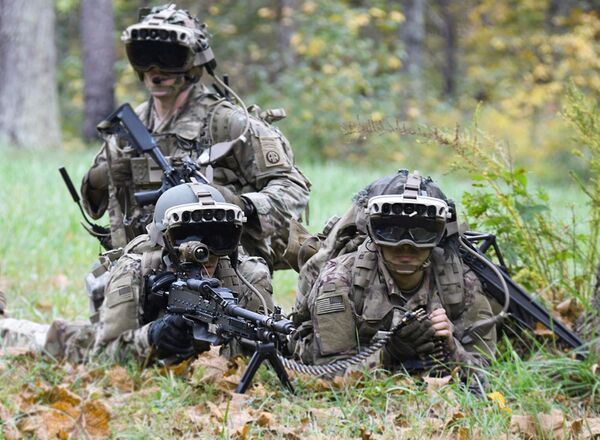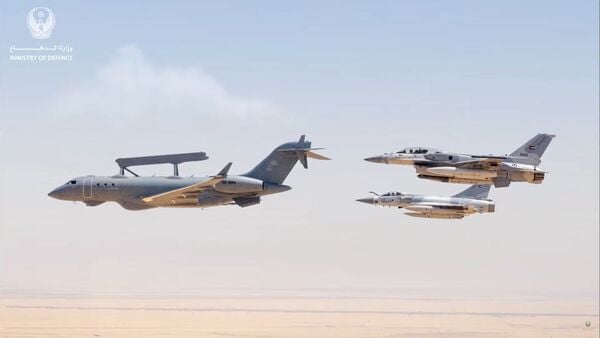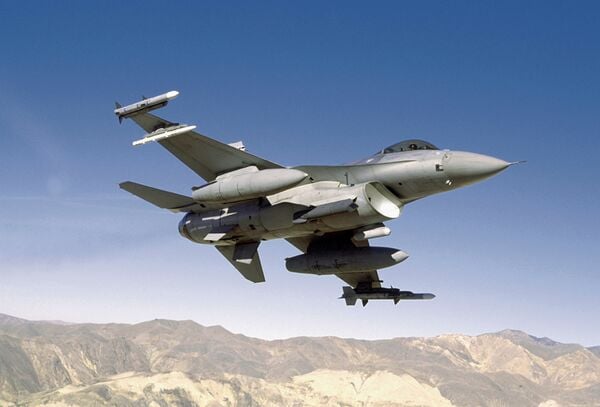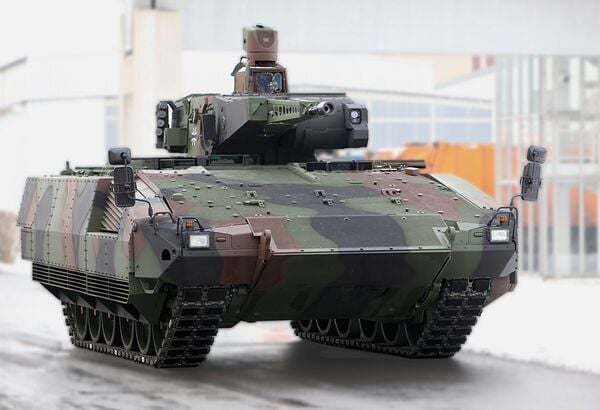- About
- Intara
- Capabilities
- Advisory
- Resources
- News
- Store
US Army soldiers experienced physical side-effects using IVAS, Pentagon report finds
01 February 2022
by Ashley Roque


Soldiers from the US Army's 82nd Airborne Division used an IVAS prototype during solider touchpoint 3 in October 2020 at Fort Pickett in Virginia. (US Army)
US Army soldiers experienced a range of physical ailments from headaches and nausea to neck strain while donning Microsoft's militarised HoloLens 2 augmented reality (AR) system during testing last year and they were unable to complete essential combat tasks, according to the Pentagon's chief weapons tester.
Service leaders postponed the initial operational test and evaluation benchmark for the new Integrated Visual Augmentation System (IVAS) last year after deciding they first needed to fix several hardware and software shortcomings. Pending changes include reducing the heads-up display's field-of-view from 80° to 70°, addressing a humidity issue with one component, and fixing software ‘reliability and stability' issues that sometimes ‘crash' the system, Janes has previously reported.
A newly issued “controlled unclassified information” edition of the Director, Operational Test and Evaluation (DOT&E) annual report for 2021 provides additional details about these IVAS problems and gives a limited insight into soldiers' feedback on the technology they are expected to use on the battlefield and for training.
UAE inaugurates GlobalEye early warning aircraft
25 April 2024
by Jeremy Binnie


The UAE's fourth Saab GlobalEye was delivered on 18 April. (Ministry of Defence of the United Arab Emirates)
The Ministry of Defence (MoD) of the United Arab Emirates (UAE) announced on 24 April that a reception ceremony for an early warning aircraft had been held at Al-Dhafra Air Base.
It cited Major General Ibrahim Nasser al-Alawi, the commander of the Air Force and Air Defence (AFAD), as saying the aircraft was a “qualitative addition” that will help protect the country's strategic interests.
The MoD released a video showing a Saab GlobalEye airborne early warning and control (AEW&C) aircraft without AFAD markings being escorted by F-16 and Mirage 2000-9 fighters before landing at Al-Dhafra, as well as personnel with 8th Aviation Wing badges working at a ground station.
Saab confirmed on the following day that it delivered the fourth of five GlobalEyes ordered by the UAE on 18 April.
Lockheed Martin to ramp up UK Sniper production
24 April 2024
by Gerrard Cowan


Seen being carried by a US Air Force F-16, the Sniper ATP is built in Florida in the US and Bedfordshire in the UK. Lockheed Martin is now ramping up UK component production to meet increased customer demand. (Lockheed Martin)
Lockheed Martin is building a new production line for AN/AAQ-33 Sniper Advanced Targeting Pod (ATP) components at its Ampthill, Bedfordshire site in the UK, seeking to meet anticipated demand from NATO allies and other customers for the system, the company has told Janes .
The UK-based work on Sniper supports the manufacturing activities at Ocala, Florida. This work has been expanded with a new production line at Ampthill that will focus on producing cabling to integrate the system into aircraft.
Stacy Kubicek, Lockheed Martin's vice-president and general manager – sensors and global sustainment, said the fresh investment is part of a wider strategy at Lockheed Martin. She placed it into the context of a shifting outlook among customers.
Germany orders simulators for Puma IFVs
19 April 2024
by Olivia Savage


The Bundeswehr has ordered 258 sets of AGDUS systems for its Puma IFVs following successful integration tests. (PSM GmbH)
The Bundeswehr is receiving new training simulators for its Puma infantry fighting vehicles (IFVs).
In total, 258 sets of Training Device, Duel Simulator (Ausbildungsgerät Duellsimulator: AGDUS) systems are being delivered for the Puma IFVs by the end of 2026, the Bundeswehr announced on 15 April.
The EUR109 million (USD116 million) contract will be financed from the EUR100 billion Bundeswehr special fund.
A Rheinmetall/Krauss-Maffei Wegmann (KMW) consortium received an order from the Bundeswehr in December 2019 valued at EUR54 million for the provision of six AGDUS systems for integration tests on the Puma. Full-scale serial production of AGDUS would then begin once testing was complete, with up to 252 Puma IFVs being equipped with the systems for EUR88 million.
A Rheinmetall spokesperson confirmed to Janes that the company, along with KMW+Nexter Defense Systems (KNDS) Germany, are supplying the new AGDUS simulators to the Bundeswehr and that full-scale production has now officially begun.
US Army soldiers experienced a range of physical ailments from headaches and nausea to neck strain w...
Latest Podcasts
Iran Israel analysis
In this podcast Janes analysts discuss the Iranian attacks on Israel on the 14 April. They highlight the military systems used by Iran and the performance and impact of these on Israel. They also discuss the implications of this attack goi...
Listen nowJanes Case Studies
Using Janes Intara to build a common intelligence picture: Russian build up on the Ukrainian border
View Case StudyNews Categories
 C4ISR Details
C4ISR Details